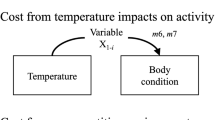Summary
Several theoretical models have suggested that increases in territory overlap with conspecifics should result in lower rates of resource accumulation by territorial residents. This assumption was tested using juvenile Anolis aeneus lizards, which exhibit variable degrees of territory overlap in both the field and laboratory. In a series of laboratory trials under controlled density and resource conditions, juvenile growth rates were negatively related to the degree of territory overlap. This effect aplied to juveniles of all but the lowest status groups, although higher status juveniles had more exclusive territories than did lower status juveniles. Focal studies indicated that food depletion in the zones of overlap was the most likely reason for the negative relationship between territory overlap and growth. It is suggested that juveniles in the field may tolerate extensive territory overlap in spite of growth penalties because of a general shortage of predator-safe homesites in undisturbed habitats.
Similar content being viewed by others
References
Archer J (1970) Effects of population density on behaviour in rodents. In: Crook JH (ed) Social behavior in birds and mammals. Academic Press. London
Brown JL (1982) Optimal group size in territorial animals. J Theor Biol 95:793–810
Davies NB, Houston AI (1981) Owners and satellites: the economics of territory defense in the pied wagtail, Motacilla alba. J Anim Ecol 50:157–180
Ewald PW, Hunt GL, Warner M (1980) Territory size in western gulls: importance of intrusion pressure, defense investments and vegetation structure. Ecology 61:80–87
Frank F (1957) The causality of microtine cycles in Germany. J Wildl Manage 21:113–121
Gaston AJ (1978) The evolution of group territorial behavior and cooperative breeding. Am Nat 112:1091–1099
Jannett FJ (1978) The density-dependent formation of extended maternal families of the montane vole Microtus montanus nanus. Behav Ecol Sociobiol 3:245–263
Jannett FJ (1981) Sex ratios in high density populations of the montane vole, Microtus montanus and the behavior of territorial males. Behav Ecol Sociobiol 8:297–307
Maza BG, French NR, Aschwanden AP (1973) Home range dynamics in a population of heteromyid rodents. J Mammal 54:405–425
Myers JP, Connors PG, Pitelka FA (1981) Optimal territory size in a variable environment. In: Kamil AC, Sargent TD (eds) Foraging behavior. Garland Press, New York
Ono KA (1981) The effects of habitat structure on the social behavior and spacing patterns of juvenile lizards (Anolis aeneus). PhD thesis, University of California, Davis, Calif
Schoener TW (1983) Simple models of optimal territory size: a reconciliation. Am Nat 121:608–629
Sokol RR, Rohlf FJ (1981) Biometry, 2nd edn. Freeman, San Francisco, Calif
Stamps JA (1978) A field study of the ontogeny of social behavior in the lizard Anolis aeneus. Behaviour 66:1–31
Stamps (1983a) The relationship between ontogenetic habitat shifts, competition and predator avoidance in a juvenile lizard (Anolis aeneus). Behav Ecol Sociobiol 12:19–33
Stamps JA (1983b) Territoriality, and the defense of predator-refuges in juvenile lizards. Anim Behav 31:857–870
Stamps JA (in press) Rank-dependent compromises between growth and predator protection in lizard dominance hierarchies. Anim Behav
Stamps JA, Barlow GW (1973) Variation and stereotypy in the displays of Anolis aeneus (Sauria: Iguanidae). Behaviour 47:67–94
Stamps JA, Tanaka SK (1981a) The influence of food and water on growth rates in a tropical lizard (Anolis aeneus). Ecology 61:33–40
Stamps JA, Tanaka SK (1981b) The relationship between food and social behavior in juvenile lizards (Anolis aeneus). Copeia 1981:422–434
Stamps JA, Tanaka SK, Krishnan VV (1981) The relationship between selectivity and food abundance in a juvenile lizard. Ecology 62:1079–1092
Stamps JA, Tollestrup K (in press) Prospective resource defense in a territorial species. Am Nat
Young H (1951) Territorial behavior in the Eastern Robin. Proc Linn Soc NY 5:1–37
Author information
Authors and Affiliations
Rights and permissions
About this article
Cite this article
Stamps, J.A. Growth costs of territorial overlap: experiments with juvenile lizards (Anolis aeneus). Behav Ecol Sociobiol 15, 115–119 (1984). https://doi.org/10.1007/BF00299378
Received:
Accepted:
Issue Date:
DOI: https://doi.org/10.1007/BF00299378




